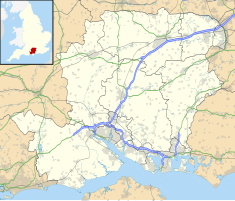Andover Guildhall
| Andover Guildhall | |
|---|---|
 Andover Guildhall | |
| Location | High Street, Andover |
| Coordinates | 51°12′28″N 1°28′45″W / 51.2078°N 1.4793°WCoordinates: 51°12′28″N 1°28′45″W / 51.2078°N 1.4793°W |
| Built | 1825 |
| Architectural style(s) | Neoclassical style |
Listed Building – Grade II* | |
| Official name | Guildhall |
| Designated | 24 February 1950 |
| Reference no. | 1236337 |
 Shown in Hampshire | |
Andover Guildhall is a municipal building in the High Street, Andover, Hampshire, England. The guildhall, which was the headquarters of Andover Borough Council, is a Grade II* listed building.[1]
History[]
The first guildhall in Andover was built in around 1513[2] and remodelled in 1574.[3] By the early 19th century it had become dilapidated and civic leaders decided to erect a more substantial structure on the same site.[4] The new building was designed in the neoclassical style, built in ashlar stone and was completed in 1825.[5] The design involved a symmetrical main frontage with five bays facing south down the High Street; the central section of three bays, which slightly projected forward and was rusticated, featured three round headed openings on the ground floor and three sash windows on the first floor flanked by Doric order columns supporting an entablature, a frieze and a large pediment.[1] The frieze featured circular decorations above the columns and also recorded the date of completion.[1] At roof level, there was originally a central clock tower but the clock was later moved to the centre of the pediment.[1]
In November 1830, during the Swing Riots, a group of 300 protesting agricultural labourers set off from the Angel Inn in Andover for Taskers Foundry at Upper Clatford where they destroyed much of the machinery:[6] the foundry must have recovered because the floor in the guildhall was strengthened with iron columns from the foundry in 1834.[7] The town hall was again at the centre of a riot in 1914, when magistrates imprisoned a teenager, Phyllis Beckenham, and her mother for non-payment of fines after, against the wishes of the court, she had accosted a shopkeeper, the supposed father of her child: a group of some 2,000 protestors, who supported the teenager, ransacked many of the shops in the High Street.[8]
During the First World War, recruitment rallies took place outside the town hall to attract potential soldiers for Kitchener's Army.[9] A war memorial, designed by Captain Herbert Cowley to commemorate the lives of local service personnel who had died in the First World War, was unveiled in front of the guildhall by the Lord Lieutenant of Hampshire, Major General J. E. B. Seely, on 5 May 1920.[10] In preparation for an expansion scheme, which did not ultimately proceed, the war memorial was relocated to St Mary's Churchyard in 1956.[11]
The guildhall continued to serve as the headquarters of Andover Borough Council for much of the 20th century[12] but ceased to be the local seat of government when the enlarged Test Valley District Council was formed in 1974.[13][14] A petition was launched in around 2014 to move the war memorial back in front of the town hall where it would be more visible[15] but, after several debates over the issue, the council announced that it had no plans to resturn the memorial to its original position.[16] The ground floor of the town hall was converted for use as a restaurant in 2010[17] but the main assembly hall on the first floor remained available for community use.[18]
References[]
- ^ a b c d Historic England. "Guildhall (1236337)". National Heritage List for England. Retrieved 18 March 2021.
- ^ Warmington, R. (1970). Timber Framed Buildings in Andover. Andover Local Archives Committee. p. 2.
- ^ Warmington 1970, p. 12
- ^ "Andover Archaeological Assessment" (PDF). Hampshire County Council. Retrieved 18 March 2021.
- ^ Pevsner, Nikolaus; Lloyd, David (1967). Buildings of England: Hampshire and the Isle of Wight. Penguin. p. 80. ISBN 978-0140710328.
- ^ "The Upper Clatford 'Swing Riot' – 1830". My Family Matters. Retrieved 18 March 2021.
- ^ Denny, David (19 November 2020). "Taskers and the Andover Riots" (PDF). Love Andover Observer. p. 22. Retrieved 18 March 2021.
- ^ "There were riots in the streets of Andover after a teenager claimed a shop owner was her baby's father". Southern Daily Echo. 20 November 2014. Retrieved 18 March 2021.
- ^ "World War I Recruitment Rally, Andover, Hampshire 1916/17". Women's Land Army & Timber Corps. Retrieved 18 March 2021.
- ^ "Andover Cenotaph". Imperial War Museum. Retrieved 18 March 2021.
- ^ Historic England. "Andover War Memorial (1402345)". National Heritage List for England. Retrieved 18 March 2021.
- ^ "Andover MB". Vision of Britain. Retrieved 18 March 2021.
- ^ Local Government Act 1972. 1972 c.70. The Stationery Office Ltd. 1997. ISBN 0-10-547072-4.
- ^ "No. 46841". The London Gazette. 4 March 1976. p. 3333.
- ^ "Dispute over Andover war memorial's location". BBC. 3 February 2016. Retrieved 18 March 2021.
- ^ "'No plans' to move Andover War Memorial to Guildhall". Romsey Advertiser. 13 November 2020. Retrieved 18 March 2021.
- ^ "Restaurant at Andover Guildhall to open in 'late summer'". Andover Advertiser. 25 June 2010. Retrieved 18 March 2021.
- ^ "Andover and History and Archaeology Society". Andover Advertiser. 9 February 2017. Retrieved 18 March 2021.
- Government buildings completed in 1825
- City and town halls in Hampshire
- Andover, Hampshire
- Grade II* listed buildings in Hampshire
